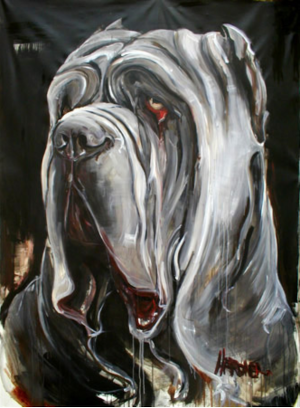
“Heritage.”
At the top of every page on this site is the sentence, “Celebrating the heritage, diversity, and predictability of the purebred dog,” and for the purposes of this post, we reemphasize the word, “heritage.”
Sometimes, a society can underestimate what a dog breed means to their culture, and it isn’t until the breed is close to vanishing that the realization is made: A dog breed is as ethnically significant as a culture’s language, cuisine, native dress and music. Italy learned that after the war in the 1940s.
World War Two had encircled the globe forcing nearly every country on Earth to align with one of two massive military alliances. Approximately 3% of the world population died during the war. Italy, a small country, was in ruins. More than 153,100 civilians had been killed, along with over 300,000 Italian soldiers. Nearly half of the Italians who fought in Russia never made it home. Some 10 percent of the physical plant of Italy was destroyed in the fighting, many towns and villages completely destroyed.
The war over, Italy was a country was in need of a boost, and they found one in the form of a huge, wrinkly dog. Several Italians began to organize and promote the Neapolitan Mastiff, Piero Scanziani, a well known artist, among them. Italians were receptive to rallying around their “native son,” and fanciers like veterinarian, Dr. Ruggero Soldati, helped publicize the breed. The first exhibition after the war was held in Naples in 1946 when six Neapolitan Mastiffs were presented. When it came time to write a standard, Dr. Piero Scanziani codified it. Napoletani breeders who had steadfastly maintained the breed under difficult war-time conditions were honored by having the breed named after them, “Mastino Napoletano” or Neapolitan Mastiff (this after some debate that the breed should be called the Molosso Romano).
The Neapolitan Mastiff came to be symbolic of a reviving Italy, an embodiment of qualities that had sustained its survivors: Endurance, perseverance, nobility of character, and might. It would be an understatement to say that Italians had pride in their canine treasure, and the sentiment continues. As Denise Flam wrote in her marvelous article, Ode To The Neo**, today the judging of the Mastino Napoletano in Europe is considered to be synonymous with connoisseurship because (these are our words, now), there is an admiration, if not passionate regard for molossers, considered to be the forebears of working breeds.
In Italy, the breed will always be remembered as the “Big Dog of the Little Man,” an extraordinary dog for ordinary men who lived on farms and worked on estates across Italy.
**Reading the article in Modern Molloser may require a modest subscription fee, but it is well worth the price for anyone interested in molosser breeds.
Image found on Pinterest might be attributed to Magnus Härdner but we are still searching for the artist’s website
